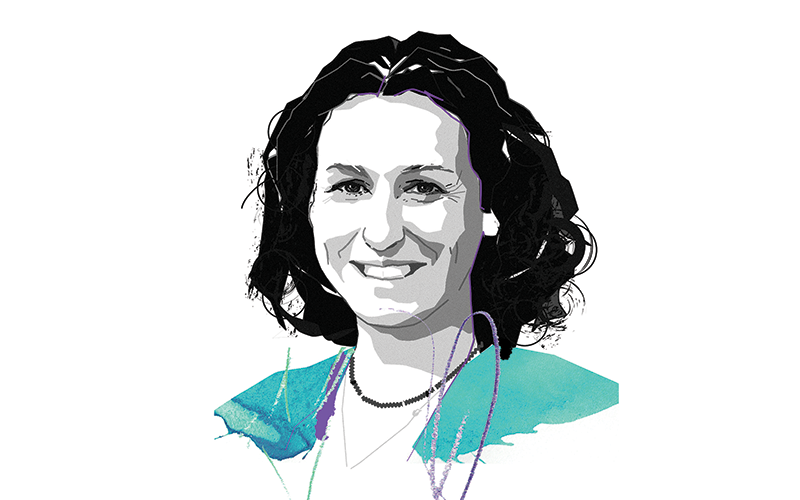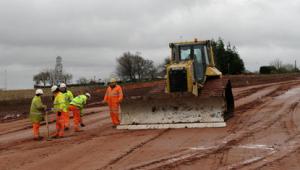
THE IMPACT OF HOMES AND PLACES on people’s lives should not be underestimated. How we create neighbourhoods, regenerate places and manage development will help or hinder efforts to tackle many issues, including health inequalities, climate change, and the economic resilience of our villages, towns and cities. And it is not just those with an interest in planning and place-shaping that recognise this. England’s chief medical officer, Professor Chris Whitty, said at our annual conference in late 2022 that, in his view, proper planning had probably done more for public health over the past 50 years than almost any other intervention other than vaccination programmes.
The Covid-19 lockdowns brought the importance of the quality of where people live and their local area to the forefront of many people’s minds. This profound link between housing, places and health has, however, been known about for some time. As set out in the Health Equity in England: The Marmot Review 10 Years On report, published in 2020, we know that substandard housing increases the likelihood of respiratory, cardiovascular and communicable diseases, as well as mortality. Poor-quality housing is associated with poor mental health, and can cause stress, depression and anxiety. Our neighbourhoods are also crucially important to our mental and physical wellbeing. Those that discourage walking and have poor cycling infrastructure can affect residents’ mental wellbeing and increase the risk of type-2 diabetes, cardiovascular diseases and musculoskeletal conditions.
The report also highlighted that for those living in more deprived districts and regions, health is getting worse and health inequalities are increasing. This is an important part of the context in which we are currently living and working. The climate, nature, housing and health crises will not affect everyone to the same extent. Disadvantaged communities will generally face the biggest challenges.
There are also economic and environmental drivers for taking a more holistic approach to place-making. While there is a need to revitalise and regenerate many town centres and high streets, the economic case is much more significant than that. In November 2022, Andy Haldane, current chief executive of the RSA and former chief economist of the Bank of England, gave a lecture entitled Health is Wealth? as part of a Health Foundation series. In it, he argued that the links between health and the economy are deep-seated and have never been more crucial than at present. Natural England has estimated that £2.1 bn per year could be saved in health costs if everyone in England had good access to green space, as a result of increased physical activity in those spaces.
In relation to poor-quality housing, a study by the Building Research Establishment found that it was costing the NHS £1.4 bn each year to treat people affected. If societal costs such as those relating to care, loss of economic potential and mental health are included, then the full cost to society of poor housing is estimated to be £18.5bn per annum.
Risk reduction
While the NHS has a critically important role in providing healthcare for people once they are ill, the built and natural environments have a key role in preventing and reducing the risk of ill health.
‘Places can also help strengthen local economies by keeping jobs and money local’
Green space, which is commonly referred to as part of green infrastructure, has social and economic benefits. Of course, it also provides environmental benefits, including biodiversity, carbon sequestration, natural flood risk management and natural cooling effects. Making space for local food production can also help provide the community with healthy, locally sourced fresh food. The role of transport infrastructure is also important. Reducing people’s dependence on private cars by reducing the need to travel long distances and by promoting active travel will have multiple benefits. So, the case for high-quality homes and communities is strong, but what does it mean in practice?
Complete, compact and connected communities
In response to the various challenges society faces, we have seen a renewed interest in the idea of complete, compact and connected communities. In Paris, the concept has been referred to as the ’15-minute city’; in Melbourne, the phrase ‘20-minute neighbourhood’ is being used. The latter is based on research that found that 20 minutes is the maximum time people are willing to walk to meet their daily needs. A 20-minute journey allows for an 800 metre walk from home to a destination and back again. Regardless of the name, the focus should be on creating attractive, interesting, safe and walkable places in which people of all ages are happy to travel actively from home to the services they need to use and the places they want to visit. This is likely to include shops, schools, community and healthcare facilities, green spaces and places of work. As well as promoting and enabling active travel by reducing the need for people to travel greater distances by private car, such places can also help strengthen local economies by keeping jobs and money local.
We should keep in mind that the design and characteristics of a neighbourhood and what success looks like will vary from place to place. While the local planning authority is likely to have a key role, co-producing a vision and the details with the community should be an important part of the process. There are likely, however, to be some key components to the neighbourhood, whether consideration is being given to creating a new community or retrofitting the idea to an existing place. Thought should be given to the following elements:
- Diverse and affordable homes
- Well connected paths, streets and spaces
- Schools and educational facilities at the heart of the community
- High-quality green and blue spaces
- Local food production
- Community health and wellbeing facilities
- A place that meets the needs of all ages
Inevitably, a complete, compact and connected community will look different in rural and urban contexts. It should not, however, be written off in more sparsely populated areas. In a rural context, the emphasis should be on complete and connected communities – whereby facilities and services might be spread across a number of well connected villages. Or, for places with a market town, this can become the focal point for the complete, compact community, so that although people might have to travel to the town, once there the majority of their needs can be met.
Principles for success
Both the barriers and opportunities for creating complete, compact and connected communities will vary from place to place. A universal challenge is likely to be resource constraints, so the role of the local community, including local businesses, may be vitally important. In other locations, the idea will need to be driven by the local authority if it is to succeed.
Through work with local authorities across the UK, and drawing on case studies from across the world, the Town and Country Planning Association developed a guide for council planners looking to develop healthier, active and prosperous communities. Through this work, a number of principles for success were identified.
‘While the 20-minute neighbourhood idea is a simple one, implementing it will require local leadership, community engagement and determination’
A compelling vision that is well communicated – high-level political support within a council is needed, just as partnership working with a range of stakeholders will be. Change in a local area can be difficult to achieve, so, if multi-faceted change is to happen, there needs to be a clear vision for the future of the neighbourhood that is supported as widely as possible and can be communicated clearly and consistently. This needs to be accompanied by strong, visible and inspiring leadership. This leadership can come from different sources – it could be a champion within the community, or an elected politician, who can bring together partnerships and mediate between different groups.
While leadership is important, there is also a need to empower communities. Local knowledge should be at the heart of the vision of an area’s future, and this should include engaging with residents and businesses as early as possible to understand their needs and aspirations in relation to both improving existing places and new development. Achieving change will also require partnership and advocacy across local council departments, often between local authorities in two-tier areas, and effective partnerships with a range of stakeholders and organisations.
Research, data and analysis is important throughout the process. Councils already have a lot of useful data about their local communities, so this is not necessarily about commissioning new studies. Data on flood risk, carbon accounting, socioeconomic data, data from public health teams and traffic flows should all underpin thinking and inform the baseline. Evaluation and adaptation are also critically important. Some interventions will work more effectively than others, and elements will be progressed at different speeds. Monitoring outcomes and adapting interventions is an important part of the process.
A commitment to addressing inequalities should be included in the vision for the area and this should flow through into the objectives and priorities. Investment and project implementation should prioritise meeting the needs of the least wealthy, as they are likely to experience the worst health. The City of Oakland in California is an example of a place that has developed an equity framework as a way of measuring inequalities to inform policies that address disparities across the city.
Specific tools for implementing the vision will include adopting policies in the local development plan and, potentially, neighbourhood plans. These policies must set out clear expectations of what is required from development and will provide hooks that strengthen the ability of local planning authorities to deliver the features of the vision for the neighbourhood, both through the development proposals they consent to and through negotiations on Section 106 agreements. While local authorities can deliver the ‘hard’ infrastructure to enable people to live more locally, they also have a role in delivering the ‘soft’ measures needed to support their use and instil behaviour change. And, inevitably, it will require investment, including through staff time and resources. Funding is likely to come from a range of sources. This might be through competing for funding from central government, such as levelling up funding, or through the use of developer contributions. New sources of funding that will be available in the future include biodiversity net gain, which will generate funding to create or enhance green infrastructure close to developments that are unable to provide a ‘net gain’ in biodiversity onsite.
While the 20-minute neighbourhood idea is a simple one, implementing it will require local leadership, community engagement and determination. While I am a strong advocate of the transformational role of planning, it cannot be achieved by planners alone. To develop a vision and implement it successfully will require cross-local authority commitment and community buy-in. But the potential benefits that could be unlocked by implementing that vision are vast.
Fiona Howie is chief executive of the Town and Country Planning Association




















